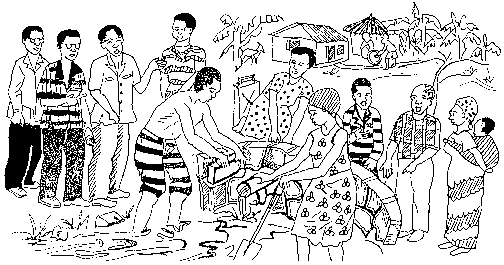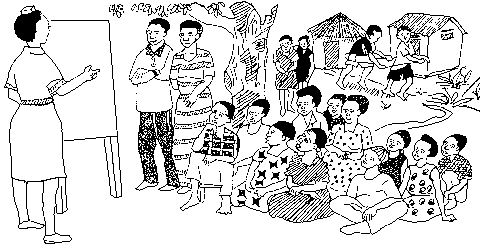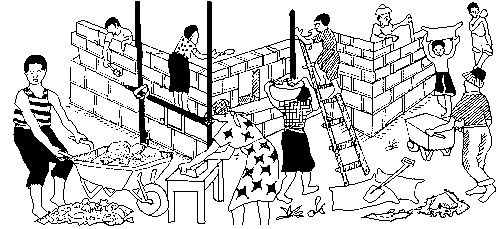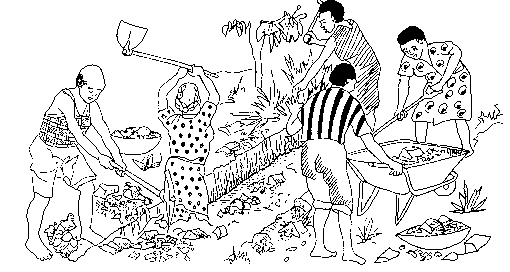Tweet
Translations:
Other Pages:
Modules
Site Map
Key Words
Contact
Utility Documents
Useful Links
Contents:
Contents:
Contents:
Contents:
Contents:
Contents:
Contents:
Contents:
Contents:
Contents:
CHAPTER THREE
Training to Empower Communities
Training for Strength; A Community Management Training Methodology
by Phil Bartle, PhD
3. Management Training to Empower Communities:
This chapter looks at several management training principles, methods and topics, to apply them to the empowerment and increased capacity of low income or marginalized communitiesTo complement this section, the Community Management Training Handouts, can be reproduced and translated into local languages for handing out to community groups when mobilizing and organizing them..
3.1. A Community Management Training Curriculum:
A "curriculum" is a plan of action applied to a training programme. CMP developed a curriculum in response to community- expressed needs as CBOs decided upon, planned and implemented their projects. This curriculum material can be found in the document Framework for a Community Management Training Curriculum, which can be used for planning a programme for strengthening low income communities.
3.2. The Purpose of Community Management Training:
This is training for group organizing for action, not merely for skill transfer or for giving information to individuals.
It can not be emphasized too much that training, as a method for strengthening low income communities, for poverty reduction, for promoting community participation, for practical support to democratization and decentralization, ie for mobilizing, is far from being only the transfer of information and skills to the trainees. This is non orthodox training. Formalization and institutionalization of this kind of training brings with it the danger of emasculating the training, of emphasizing the skill transfer over the encouragement, mobilization and organizing aspects of the training.
Management training in this sense was developed for strengthening the effectiveness of top and middle management in profit making corporations. It has been modified here, and integrated with techniques of trade union organizing, for the purposes of mobilizing and strengthening the capacity of low income communities to come together and help themselves, and engage in developmental social change.
Illustration 5: Community Technical Training;
Ministry Experts in Dialogue:
 |
3.3. Four Essential Planning Questions:
If we take the overall decision making processes, which vary from context to context, we can distil all to four essential questions. Answering of these questions (which does not have to be so brief) constitutes the basic management planning process.
These four questions are:
- What do we want?
- What do we have?
- How can we use what we have to get what we want? and
- What will happen when we get it?
If you look carefully, they are the four questions included (perhaps disguised by elaboration) in any project planning document (eg project proposals, see more below), and in the technique of brainstorming described later and in the appendices.
The "What do we want?" question covers the description of the problem. Its answer is the general goal, then specific objectives, outputs and other finer definitions of that goal. In community management training the "What do we want?" question must be answered by the community as a whole, not just the men, not just the educated, not just the civil servants, not just the cronies and friends of the agency, but by all of the community, by consensus.
The "What do we have?" question is the identification of resources or potential inputs that can be used to reach the chosen goal. In community management training, this identification is best done in meetings where the quiet people are encouraged to participate, because there are many resources in every community, including the poorest, that are hidden or perhaps not so obvious. A skilled mobilizer can draw out of a community meeting, by participatory facilitation, the identification of many otherwise hidden or disguised resources.
Resources include available labour and expertise (the human energy ready to be employed in the activity), land or space on which to carry out the activity, cash (through charges, sales, donations and other sources), capital (reusable equipment or tools) needed to carry out the activity, and human mental resources (wisdom, information, experience, skills, analytic capacity, creativity) often the hidden contributions of old or retired people, and often found in those who are physically disabled or socially ostracized. Many of them are so obvious they are otherwise overlooked.
The "How do we get what we want with what we have?" question is the strategy part of the craft of management. There are always several different ways to combine the available resources, and the collective mental resources of the community (as mentioned above) should be used to identify several strategies, and select the most appropriate one.
The "What will happen when we get it?" question covers the prediction of the impact of the activity. It can be expanded to ask how the activity is expected to affect the community and its (social and physical) environs, and should lead to plans for community monitoring and evaluation.
In community management training, these essential four questions need to be raised when the whole community is meeting to decide priorities. They should also be used when the executive committee of the CBO meets on behalf of the whole community to work out details.
If you look carefully, you will see these four questions, in the order presented, hidden in two of this document's appendices, the brainstorming process and guidelines for project design. Whether they are asked in the process of organizing a trade union, or in a management meeting of senior executives of a wealthy corporation (or, in this context, during the empowerment and capacity building of a low income community), they constitute the essential or core decisions in management.
Illustration 6: Community Awareness;
Health and Hygiene:
 |
3.4. Some Principles in Management Training:
Once the four essential or core questions are recognized as at the centre of community management training, several other management principles can be identified. The extent to which these are included in community management training may vary according to what is needed: how much and what kind of training is appropriate at each session.
Unlike the four essential questions above, the following is an open-ended list, and does not have to be presented in the following order. They are presented here, and in the training hand out in the appendices, as a list of eight advisory precepts, "A" to "H" as listed below.
- We (the community group) need vision. The community must decide, as a whole, what it wants to do. There are many possible goals, but the community must be unified and choose what it wants to do. Trainers can use a quotation from Alice in Wonderland to illustrate this. "If we do not know where we are going, then any road will do." (Lewis Caroll). Without a vision for where the community wants to go, it might as well stay where it is or how it is (with its apathy, poverty, disease and discomfort) at present.
- Once a goal and a direction are chosen, it is necessary to make some planning decisions as to how to reach or get closer to that end. This can be illustrated during training by a catchy phrase: "If we fail to plan, then we plan to fail." (Also see "Slogans"). If success or winning can be defined as reaching the goal, then it is necessary to plan in order to reach that goal. (Of course the goal, or how it is interpreted, may change during the process of reaching it, and certainly after it is reached).
- The trainer can remind the group that planning means the series of thought processes that will lead the group for where (or in what condition) it is now, to where (or in what condition) is envisaged when the goal is reached. those though process must be logical and consistent, and lead from the present actuality to the future desired result. The trainer can point out that: "We plan backwards in time (Start with the end and end with the start)." Start planning by identifying where we want to go, then ask what steps are needed in order to get there. Every step from the current situation must logically link with the next until the desired end is reached.
- During the process of identifying and selecting strategies, the group is encouraged to make the best or most efficient and effective use of what they have to get what they want. Efficiency must not be rejected, although it can be interpreted in many ways. Efficiency can be defined as being able to "Get more output for less input (maximize our efficiency)" One catchy phrase that may illustrate this is, "Do not work hard; get results." Here the admired value of "hard work" (the means or the input) is shown to be less important than the result of that work (the end or output). It is not intended as an encouragement to be lazy, but as an encouragement to use resources (including one's own labour) wisely, and therefore (in this context) efficiently.
- A participatory and inclusive decision making process can tap hidden resources that would otherwise be lost by a dictatorial decision making style. The trainer teaches to, "Involve everybody in decisions." One (imperfect) human, even if boss or chief, has less information, experience, wisdom, than the whole concerned group, including the quiet or humble ones. In terms of democratization, it is the right of every community member to participate; in terms of maximizing the strength of a community, identifying the most of its resources, and finding creative and previously overlooked strategies, involving all makes good management sense.
- The trainer must remind the community that it must aim to "stand on its own feet." Dependency, and reliance on outsiders' help, resources, and even direction, is simply not sustainable (the outsiders leave after some time), as well as a weakness and vulnerability. Encourage self reliance; it is an obligation or duty as well as a right. Another catchy phrase can be used here: "If you blame others, you give up your power to change," (Ray Anthony). The trainer must never be duped by the dependent plea, "We are too poor and we need outside help." Every (every) group or community, no matter how poor, if it is composed of live humans, has resources it can tap, most of which are hidden. The real poverty is in the lack of knowing what they are, not in their absence.
- There is no free lunch (nothing is for nothing). Volunteer labour and public donations must be paid for, even if not in purely monetary currency. That payment may be public recognition, encouragement, praise and acknowledgement. Management trainers in corporations have pointed out that even paid labour does not participate fully or produce the most just on the basis of salaries or wages; recognition, praise and encouragement go a long way to get the best output from both volunteers and paid labour. Recognize contributions, praise honestly, emphasize the positive, ignore the negative, do not criticize.
- We cannot stand still. If we are not going forward, then we will slip backward. Human society is dynamic, it is always changing. It is impossible to solve any problem, "once and for all," (that is a fallacy). What may be today a solution to a problem, if it is continued to be used, may tomorrow be the problem.
Of course there are many other lessons and principles in management training. This web document cannot list or describe them all. You are invited to identify more. As you do, add them to your personal professional bag of tricks in mobilizing, and also share them with us and with your colleagues.
Illustration 7: Community Management Training;
Financial Accounting Workshop:
 |
3.5. Techniques of Encouragement:
It is important to recognize that the number one hindrance to successful community based projects is discouragement. When clients get discouraged, project action slows (or even halts); something can prevent and counteract.
Second, experience has shown that the number one cause of discouragement is criticism. Criticism is never required, and usually has negative results on any action.
In management training, there is a slogan that illustrates an important principle about this, " You do not have to be bad to get better." This means that anyone can improve, if shown how, without being told that they are not good. We all want our clients, target groups and staff to improve their performance. What is important to us is that we can encourage and help them to improve without pointing out their faults.
When we give written feedback, we can involve this principle in several ways. One is a list of titles or topics that we can follow in writing feedback to reports or other submitted work:
- What was good about your report/action/activity/ .. ;
- What can be improved about it;
- What we agree about it;
- What we disagree about it; and
- Some recommendations (eg further action, corrections).
These form a set; all five should be included. A person will more carefully listen to our suggestions for improvement if we first point out what she or he did right or well.
When a client, volunteer or staff member does some thing with which we disagree or that should never be repeated, we can still take action. Please excuse the crude vocabulary, but we can serve what in management training is called a "shit sandwich." (You might object to the term, but you will remember it now). In such a sandwich, on either side of the part we do not like is the bread (which we do like).
It goes like this: (a) start with honest praise, pointing out the good things, (b) make suggestion for improvement and why, then (c) finish with more honest praise. The client or staff member is more likely to accept and listen to the unpleasant "(b)" if it is sandwiched in between the "(a)" and "(c)."
Illustration 8: Community Contribution;
Bringing Material:
 |
3.6. A Positive Attitude and Proactive Problem Solving:
Management trainers in corporations have found that a positive, problem solving approach is more productive and effective for the organization than a negative, problem raising attitude. So too, for empowering communities. Problems exist. That is a fact of life.
Management is a process of solving problems. If there were no problems then there would be no need for management. It is important to instil in everybody concerned (not just the "boss" or the executive committee) that it is their business to suggest solutions to the inevitable problems. Community management training should include in its curriculum the encouragement of this attitude.
One technique that can be taught is through the manipulation of words, which can be used to see any problem from a new perspective. One way, for example, is to write the problem down, on a piece of paper or up on a board in front of participants. Then cross off the word "problem" and write the word "opportunity" in its place. It is a simple tip, but can bring surprisingly good results.
Most mobilizers and animators know the value of a good story, metaphor, parable or anecdote. Here is an appropriate one. Mother Theresa, of Calcutta slums fame, was known for her perpetually positive attitude. One news reporter complained to her that she acted as if she had no problems; how did she do it? "Oh, I have problems," Mother Theresa was reported to have replied. "But when I get them, I simply rename them. I call them gifts," she said.
3.7. The Managing of People:
The emphasis on honest praise, and the suppressing of criticism as anti-productive, is part of a whole methodology of management training (which we use in empowering communities). (2)
Footnote (2): This approach has been well presented by K. Blanchard and S. Johnson in their series of "The One Minute Manager," books. Designed for management training in corporate organizations, these methods and principles also can be adapted to strengthening low income communities and community groups. If you get a chance, read their books and discover more details about each of the above. Your suggestions for applying such principles are invited.
We must be reminded that although human labour, ideas and energy can be seen as resources or inputs for community projects (or any productive activities), human beings are also the reason why we want the community facilities and services in the first place, and why we want to empower low income communities to determine their own development destinies. When we mobilize people to organize and engage in community activities, they will give more of themselves if they are not burdened with the luxury of low self esteem. When we mobilize people to organize and engage in community activities, they will give more of themselves if they are not burdened with the luxury of low self esteem.
People who feel good about themselves produce good results. When mobilizing and organizing people, then, a good trainer or mobilizer will get better results in putting some effort into finding and using ways to encourage the people to feel better about themselves. It may be an immediate and thoughtless reaction, when you want a good thing produced and in a good manner, to criticize people when they do it incorrectly.
People, however, are more willing to improve when the good things they do are praised and recognized than when attention is drawn to the mistakes they make, and they feel hurt by criticism of their mistakes. Help people reach their full potential; catch them doing something right. In other words, look for the good things people have done and draw attention to them, and they will work harder at continuing them, and improving them. When no attention is paid to their mistakes, they will quietly strive to improve them.
Working with people takes time and patience. People are less predictable and less able to be manipulated than tools and other inanimate things. Working with people requires more wisdom, energy and experience than working with things. In terms of improvement of conditions and of long term and sustainable results, however, investing your time, your attention, your interest, in people, is far more valuable that the same amount of investment in things. he best minute we spend is the one we invest in people. Note the word "invest." It means that we are not just "giving" our time and energy; we are "investing," and that means we can expect some valuable returns on our investment.
We can easily get discouraged by seeing what people can not do. We are tempted to divide people into two categories; winners and losers. If we do that, we lose the potential of those we dismiss as losers. Everyone is a potential winner; some people are disguised as losers; don't let their appearances deceive you. If we spend some time and energy in helping those we see first only as losers, to win at something, we will reap considerable benefits in what we want to achieve.
It is valuable to stand back from ourselves and neutrally observe our selves and our behaviour. We will see that we are human beings ourselves. We are not just our behaviour; we are the person managing our behaviour. If we want to be managers of people, we must then see that we must each manage the closest person we know; our self. Self management precedes management of other people.
All people have desires, needs and wants. When they do something to reach them, they can be called goals. Goals begin behaviours; consequences maintain behaviours. The desire may be enough to begin action towards reaching a goal, but the results of those actions are important in continued action aimed at reaching that goal. Management and planning must start by the identifying and setting of goals (general) or objectives (specific and verifiable). We must not forget, however, that reaching those goals does not end with merely deciding what they should be. We must take actions that will encourage the achievement of those objectives.
When people get discouraged, then they are likely to reduce their efforts. They need more than praise and exhortations to continue. They need to see some results that show them they are on the path to success. Only positive consequences encourage good future performance. Negative consequences result in a decline in the quality of efforts.
Most people work well when they are supervised; they appreciate the interest shown in them as they work, and wish to demonstrate that they can work well. So when a coordinator or manager shows up, they work well. But do they work as well when the manager is absent? As a manager the important thing is not what happens when you are there but what happens when you are not there. A good manager ensures that the people who are working, volunteers or paid staff (the same principle applies to both), work as well when not being supervised as when they are supervised.
No one likes to feel criticized, and when they make mistakes, they do not want to feel belittled. The good manager learns how to ensure that when a worker makes a mistake that they learn from the mistake, and improve their work so as to avoid making the same mistake again. When a manager ends a reprimand with a praising, people think about their behaviour not the manager's behaviour. Every one wants to know how well they are doing. Feedback is a very valuable activity for any manager to provide. Getting that feedback, the workers are motivated to try harder, and to sustain their efforts.
Getting effective results is not a static condition, but a process. Achieving good performance is a journey not a destination. Putting management effort into a community project "once and for all," is like trying to eat "once and for all."
Strive for excellence, not perfection. Anything worth doing does not have to be done perfectly - at first.
It can be improved.
––»«––
Illustration 9: Community Action;
Digging a Trench:
 |
Note: To copy or download each image from its URL, right-click on it and choose the "Save_Picture_As" option in the pull-down menu. Also see Community Strengthening Cycle Illustrations , Disaster Illustratons, Income Generation Illustrations and Extra Illustrations for complete sets with no text. You can down load the illustrations from there for producing your own training material.
- Introduction:
Training For Strength - Chapter One:
Introducing Management Training for Communities - Chapter Two:
Training for Community Action - Chapter Three:
Management Training to Empower Communities - Chapter Four:
Training in Community Management Programme - Chapter Five:
Some Players in the Strengthening Methodology - Chapter Six:
Some Other Essential Training Topics